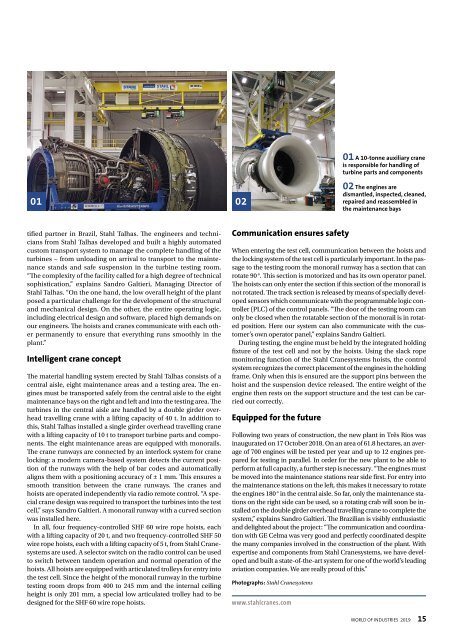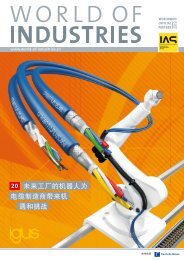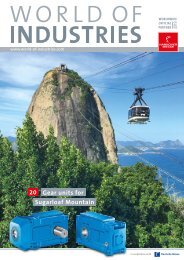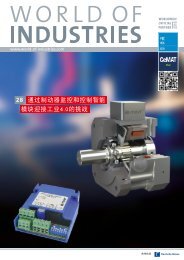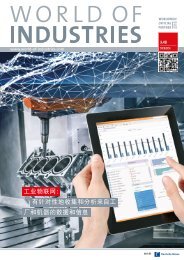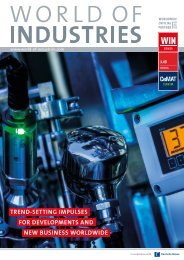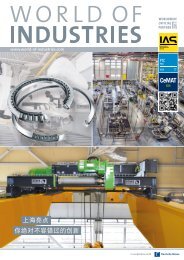WORLD OF INDUSTRIES 04/2019 (EN)
WORLD OF INDUSTRIES 04/2019 (EN)
WORLD OF INDUSTRIES 04/2019 (EN)
You also want an ePaper? Increase the reach of your titles
YUMPU automatically turns print PDFs into web optimized ePapers that Google loves.
01 A 10-tonne auxiliary crane<br />
is responsible for handling of<br />
turbine parts and components<br />
01 02<br />
02 The engines are<br />
dismantled, inspected, cleaned,<br />
repaired and reassembled in<br />
the maintenance bays<br />
tified partner in Brazil, Stahl Talhas. The engineers and technicians<br />
from Stahl Talhas developed and built a highly automated<br />
custom transport system to manage the complete handling of the<br />
turbines − from unloading on arrival to transport to the maintenance<br />
stands and safe suspension in the turbine testing room.<br />
“The complexity of the facility called for a high degree of technical<br />
sophistication,” explains Sandro Galtieri, Managing Director of<br />
Stahl Talhas. “On the one hand, the low overall height of the plant<br />
posed a particular challenge for the development of the structural<br />
and mechanical design. On the other, the entire operating logic,<br />
including electrical design and software, placed high demands on<br />
our engineers. The hoists and cranes communicate with each other<br />
permanently to ensure that everything runs smoothly in the<br />
plant.”<br />
Intelligent crane concept<br />
The material handling system erected by Stahl Talhas consists of a<br />
central aisle, eight maintenance areas and a testing area. The engines<br />
must be transported safely from the central aisle to the eight<br />
maintenance bays on the right and left and into the testing area. The<br />
turbines in the central aisle are handled by a double girder overhead<br />
travelling crane with a lifting capacity of 40 t. In addition to<br />
this, Stahl Talhas installed a single girder overhead travelling crane<br />
with a lifting capacity of 10 t to transport turbine parts and components.<br />
The eight maintenance areas are equipped with monorails.<br />
The crane runways are connected by an interlock system for crane<br />
locking: a modern camera-based system detects the current position<br />
of the runways with the help of bar codes and automatically<br />
aligns them with a positioning accuracy of ± 1 mm. This ensures a<br />
smooth transition between the crane runways. The cranes and<br />
hoists are operated independently via radio remote control. “A special<br />
crane design was required to transport the turbines into the test<br />
cell,” says Sandro Galtieri. A monorail runway with a curved section<br />
was installed here.<br />
In all, four frequency-controlled SHF 60 wire rope hoists, each<br />
with a lifting capacity of 20 t, and two frequency-controlled SHF 50<br />
wire rope hoists, each with a lifting capacity of 5 t, from Stahl Cranesystems<br />
are used. A selector switch on the radio control can be used<br />
to switch between tandem operation and normal operation of the<br />
hoists. All hoists are equipped with articulated trolleys for entry into<br />
the test cell. Since the height of the monorail runway in the turbine<br />
testing room drops from 400 to 245 mm and the internal ceiling<br />
height is only 201 mm, a special low articulated trolley had to be<br />
designed for the SHF 60 wire rope hoists.<br />
Communication ensures safety<br />
When entering the test cell, communication between the hoists and<br />
the locking system of the test cell is particularly important. In the passage<br />
to the testing room the monorail runway has a section that can<br />
rotate 90 °. This section is motorized and has its own operator panel.<br />
The hoists can only enter the section if this section of the monorail is<br />
not rotated. The track section is released by means of specially developed<br />
sensors which communicate with the programmable logic controller<br />
(PLC) of the control panels. “The door of the testing room can<br />
only be closed when the rotatable section of the monorail is in rotated<br />
position. Here our system can also communicate with the customer’s<br />
own operator panel,” explains Sandro Galtieri.<br />
During testing, the engine must be held by the integrated holding<br />
fixture of the test cell and not by the hoists. Using the slack rope<br />
monitoring function of the Stahl Cranesystems hoists, the control<br />
system recognizes the correct placement of the engines in the holding<br />
frame. Only when this is ensured are the support pins between the<br />
hoist and the suspension device released. The entire weight of the<br />
engine then rests on the support structure and the test can be carried<br />
out correctly.<br />
Equipped for the future<br />
Following two years of construction, the new plant in Três Rios was<br />
inaugurated on 17 October 2018. On an area of 61.8 hectares, an average<br />
of 700 engines will be tested per year and up to 12 engines prepared<br />
for testing in parallel. In order for the new plant to be able to<br />
perform at full capacity, a further step is necessary. “The engines must<br />
be moved into the maintenance stations rear side first. For entry into<br />
the maintenance stations on the left, this makes it necessary to rotate<br />
the engines 180 ° in the central aisle. So far, only the maintenance stations<br />
on the right side can be used, so a rotating crab will soon be installed<br />
on the double girder overhead travelling crane to complete the<br />
system,” explains Sandro Galtieri. The Brazilian is visibly enthusiastic<br />
and delighted about the project: “The communication and coordination<br />
with GE Celma was very good and per fectly coordinated despite<br />
the many companies involved in the construction of the plant. With<br />
expertise and components from Stahl Cranesystems, we have developed<br />
and built a state-of-the-art system for one of the world’s leading<br />
aviation companies. We are really proud of this.”<br />
Photographs: Stahl Cranesystems<br />
www.stahlcranes.com<br />
<strong>WORLD</strong> <strong>OF</strong> <strong>INDUSTRIES</strong> <strong>2019</strong> 15


